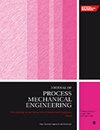洁净室空气处理装置中混合纳米流体的热物理特性:实验研究
IF 2.2
4区 工程技术
Q2 ENGINEERING, MECHANICAL
Proceedings of the Institution of Mechanical Engineers, Part E: Journal of Process Mechanical Engineering
Pub Date : 2024-07-26
DOI:10.1177/09544089241266442
引用次数: 0
摘要
纳米流体由分散在传统基础流体中的非金属或金属纳米颗粒胶体悬浮液组成,对于提高众多工业领域的传热性能至关重要。洁净室设施通过调节污染水平和环境参数来确保最佳的操作条件,在各行各业中发挥着至关重要的作用。本文通过实验研究了不同纳米粒子浓度(1%、1.5%、2%、2.5%、3%、3.5% 和 4%)的单纳米流体(Al2O3-水、CuO-水)和混合纳米流体(Al2O3-CuO-水)在原型洁净室空气处理冷水机组上的热物理特性。实验研究了单纳米流体和混合纳米流体在原型洁净室空气处理冷水机组热交换器中的热物理特性,当纳米粒子体积浓度从 1%增加到 4%时,密度分别增加了 9.27%、16.67% 和 25.91%;比热降低了 2.5%。与水相比,Al2O3-水、CuO-水和混合(Al2O3-CuO-水)纳米流体的比热分别降低了 2.53%、2.66% 和 2.17%;导热系数分别增加了 15.71%、14.70% 和 16.67%;动态粘度分别增加了 32.94%、32.47% 和 32.90%。这项研究的新颖之处在于研究了为洁净室空气处理单元量身定制的混合纳米流体,旨在提高传热效率,通过表征热物理特性和评估其性能,为推进洁净室技术提供有价值的见解,填补了该领域的重大研究空白。本文章由计算机程序翻译,如有差异,请以英文原文为准。
Thermophysical traits of hybrid nanofluids in cleanroom air handling unit: An experimental study
Nanofluids, comprising colloidal suspensions of non-metallic or metallic nanoparticles dispersed in conventional base fluids, are crucial for augmenting heat transfer properties across numerous industrial sectors. Cleanroom facilities play a vital role in diverse industries by regulating contamination levels and environmental parameters to ensure optimal operational conditions. In this paper, thermophysical characteristics of mono nanofluids (Al2 O3 –water, CuO–water) and hybrid nanofluid (Al2 O3 –CuO–water) at various nanoparticle concentrations (1%, 1.5%, 2%, 2.5%, 3%, 3.5% and 4%) on a prototype cleanroom air handling chiller unit was investigated experimentally. An experimental investigation on the thermophysical characteristics of mono and hybrid nanofluids in a prototype cleanroom air handling chiller unit heat exchanger with an increasing nanoparticle volume concentration from 1% to 4% revealed that the density increased by 9.27%, 16.67% and 25.91%; specific heat decreased by 2.53%, 2.66% and 2.17%; thermal conductivity increased by 15.71%, 14.70% and 16.67%; and dynamic viscosity increased by 32.94%, 32.47% and 32.90% for Al2 O3 –water, CuO–water and hybrid (Al2 O3 –CuO–water) nanofluids, respectively, in comparison with water. The novelty of this research lies in its investigation of hybrid nanofluids tailored for cleanroom air handling units, aiming to enhance heat transfer efficiency, offering valuable insights by characterising thermophysical traits and assessing their performance for advancing cleanroom technology, addressing a significant research gap in the field.
求助全文
通过发布文献求助,成功后即可免费获取论文全文。
去求助
来源期刊
CiteScore
3.80
自引率
16.70%
发文量
370
审稿时长
6 months
期刊介绍:
The Journal of Process Mechanical Engineering publishes high-quality, peer-reviewed papers covering a broad area of mechanical engineering activities associated with the design and operation of process equipment.

 求助内容:
求助内容: 应助结果提醒方式:
应助结果提醒方式:


